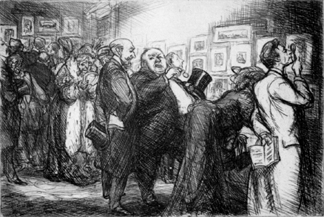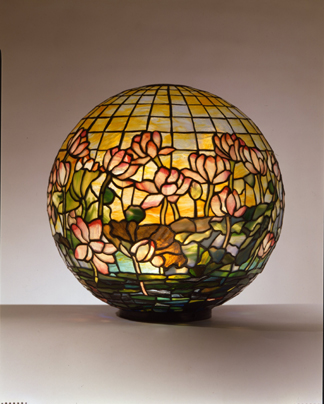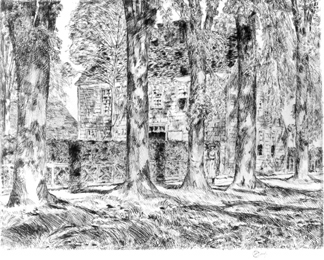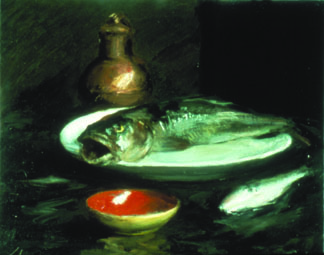
(845) 246-6944 ·
info@ArtTimesJournal.com
Around Long Island
By GINGER LEE HENDLER
ART TIMES December 2008
Photos courtesy of The Long Island Museum and Nassau County Museum of Art
|
|
A
little over a year ago, when a doctor’s appointment took me to 57th
street, I found myself with time to kill. The League was across the street.
I crossed over and walked up the stairs into the small entry hall covered
with flyers and posters announcing art lessons, exhibits, studio space,
etc. I was overwhelmed by the sense that I wanted to belong, and regretted
never having taken courses. There
was a comfort amongst the students, a community of artists, both young
and old. I was the interloper. I had finally traversed the hallowed halls,
getting but a teeny glimpse of the smells and textures of this artist’s
landmark.
 Connoisseurs of Prints, 1905, John Sloan, 1871-1951 Etching The Art Students League of New York Highlights from the Permanent Collection |
The
exhibit included approximately 75 paintings, works on paper, and sculptures.
Lithographs, landscapes, representational, and abstract expressionist
were grouped beautifully throughout the intimate galleries. The diversity
of styles and media generated a longing for the early period that spawned
such talents as Georgia O’Keefe and Jackson Pollock. I was drawn to the
spontaneous bursts of bold color, rhythmic play, and defiance of the four
modernists in the furthermost gallery. Sidney Gross’ “Untitled,” oil on
canvas, echoed bold yellows and purples. Charles Alston’s, “Red White
and Black” emanated the intensity of hot rhythms of the
jazz culture his work reflects.
Amongst
the more traditional landscapes, the one that stood out most for me was
“October Cornfield,” oil on canvas by Allen Tucker, who was involved in
the groundbreaking Armory Show of 1913. “October Cornfield” is an Impressionistic
work clearly inspired by Van Gogh, yet with more subdued pastel colors.
I
could not ignore the black and white walls, which consisted of several
small lithographs, woodblocks, and photographs. Raphael Soyer’s lithograph,
“The Team” and Will Barnett’s lithograph, “Fulton Street Fish Market,”
both depicted the working class immigrant life of the period.
With
all the special effects, graphic violence, and stark super realism of
today’s art world, I found this exhibit to be a breath of fresh air and
a wonderful look into the early roots of American artists on the cusp
of a new generation. There was warmth about this exhibit, almost like
being home.
*“The Art Students League of New York: Highlights from the Permanent Collection, The Long Island Museum, 1200 Route 25A, Stony Brook, NY 11790 (631) 751-0066 (Jul 26 through Sept 21, 2008) longislandmuseum.org
 Pond Lily Globe,1900-1910,leaded glass, 13.375 inches high X 14 inches diameter Neustadt Collection of Tiffany Glass, Long Island City, New York |
Nassau County Museum of Art:
Louis
Comfort Tiffany: Magician, Artist, Visionary, and Giver of Light!…was
a magician, pure and simple: a seer, and an artist. Combining his talents
as a designer and craftsman with the genius of Thomas Edison’s illuminating
invention was inspired. The two separate exhibits* on display have been
beautifully curated by Lindsy Parrott so that we are given a glimpse into
the many facets of LC Tiffany and his legendary work. Speak the name Tiffany
and one conjures a period of elegance and splendor. He lived on Long Island
during the Gilded Age and was the son of Charles Lewis Tiffany, the founder
of the world-renowned Tiffany and Co.; Louis, however, preferred to go
out on his own as an artist and then as an interior designer. He studied
with American landscape artist, George Inness and traveled throughout
Europe, North Africa, and the Middle East imbuing his work with the flavors
of the Renaissance as well as medieval and Byzantine periods.
“Tiffany Lamps: Articles of Utility, Objects of Art” wends its
way through three galleries and consists of approximately 45 major works
in addition to displays and sepia tinted photos of the process as well
as materials. The lamps, along with several of his windows, glow with
rich luminescent colors and sensual lines. One can envision the spirit
of the Art Nouveau period, sumptuous and regal, that Tiffany is most noted
for. “Tiffany and the Gilded Age” is a look at Tiffany’s work integrated
into a typical period setting. We are treated to a taste of the art and
furnishings, which most represent the influences these artists had on
each other. Tiffany had long-time connections with many of the American
Impressionists, Hudson River painters, and American modernists. He established
an artist-in-residence program at Laurelton Hall, his home in Cold Spring
Harbor. One can see the light in the paintings mimicking the light in
Tiffany’s lamps. The strong colors and lines of Maurice Prendergast’s
“Folly Cove, Gloucester” resonate clearly as elements of Tiffany stained
glass. American Impressionist, Childe Hassam’s “The Willows and the
Bather” features similar textures in its brushstrokes to Tiffany’s glass
designs, notwithstanding Tiffany’s intense use of natural elements. According
to the Nassau County Museum’s director, Constance Schwartz, “nature was
Tiffany’s muse,” and he was a master at inviting the spectator into the
natural world he was inspired by in his Long Island surroundings. We have
become familiar with the dragonflies and daffodils that adorn his work,
but a deeper look allows us to see how he blended the world of metal and
glass with the sensuous and organic elements found in nature. A trip to
this exhibit combined with a walk around the sumptuous grounds of the
Frick estate will make a lovely holiday outing for the family.
*“Tiffany
Lamps: Articles of Utility, Objects of Art” & “Tiffany and the Gilded
Age,” The Nassau County Museum of Art, One Museum Drive, Roslyn Harbor,
NY 11576/ (516) 484-9337, NASSAUMUSEUM.COM (Sept. 21,2008- Jan. 4,2009)
Long
Island Museum
 Adam and Eve Walking Out on Montauk in Early Spring, 1924, Childe Hassam, oil on wood panel Guild Hall |
American
Impressionist Childe Hassam is noted for his idyllic scenes of Long Island.
He once referred to East Hampton as “a beautiful little town with its
wide main street,” yet the main street he painted was closer to a silent
movie tableau, and bears no resemblance to the “Main Street” we have recently
been hearing about from the mouths of the pundits and politicians. Hassam’s
world is at times bucolic and idealized.
Golden Greek gods and goddesses pose along the Montauk shore and
ill-proportioned nudes seem awkward placed in landscapes of the Hamptons. Yet we are treated throughout to a glimpse
of the life the wealthy East End artist enjoyed. Art doesn’t have to be
disturbing and cutting edge; it can move us, soothe us, inspire and provoke
us, but doesn’t necessarily have to shock us, jolt us, and unnerve. The
exhibition of Childe Hassam, which is currently at the Long Island Museum,*
is a look back at a time when old-fashioned values were reflected in the
peaceful scenes representing the social life, well-tended gardens, and
homes of the eminent families who resided in East Hampton. Although Hassam
studied in Paris with many of the European Impressionists, he rejected
their bohemian lifestyle and chose to make his life back in New York,
where he lived a relatively patrician life and sold his work quite regularly.
“He lived with gusto, smoked a pipe, played golf, kept a good cellar,
buffeted the East Hampton surf with a great, bronzed body, and worked
joyously until his last illness,” it said in his obituary. Many of his
paintings, depicting scenes of golfers and bathers, were readily purchased
and hung in the homes and offices of fellow country club members. Walking
among the farmhouses, seaside bathers, ocean landscapes, and innocent
etchings, I was given to daydreaming about another time and place, a refreshing
escape. Hassam’s etchings were beautifully rendered and I was quite taken
with the richness of his detail and the simplicity of his lines.
 Village Elms, East Hampton, Aunt Phoebe’s House, 1923, Childe Hassam, etching New York Public Library |
The
accompanying silent film documenting his life was an excellent addition
to this exhibit. I would like to compliment the Long Island Museum for
creating a child-friendly atmosphere. Textboxes carefully placed throughout
the galleries demonstrate the care the directors and curators are taking
to cultivate the next generation of art appreciators.
*“Childe Hassam, An American Impressionist on Long Island,” The Long Island Museum 1200 Rte. 25A, Stony Brook, NY (631)-751-0066 longislandmuseum,org (Oct. 4, 2008-Feb. 22,2009)
A Look Ahead:
East
End Stories- Student Art Festival- December 14- January 4
“This multifaceted exhibition will include paintings by such artists as William Merritt Chase, Fairfield Porter and Thomas Moran, as well as an exuberant show of student work inspired by the artistic legacy of the East End of Long Island.”
Parish Art Museum, 25 Job’s Lane, Southampton, NY 11968, (631) 283-2118,
parrishart.org
Art
on Long Island is pulsing with life. As the days get shorter and colder,
take advantage of the myriad galleries and museums dotted throughout the
island’s charming villages. Give yourself the gift of art this season.
